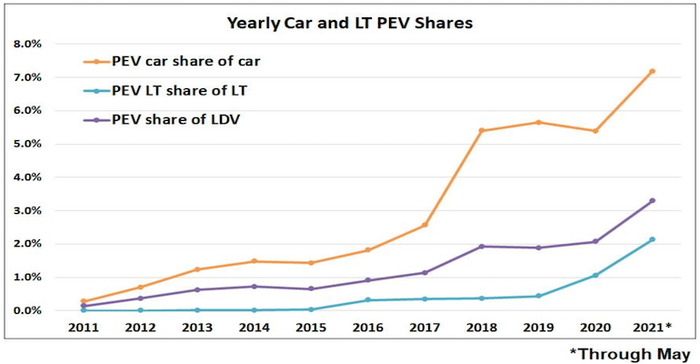The market for new EVs is growing quickly and consumers are buying more new vehicles than ever before.
June 24, 2021

Sales of electric vehicles (EVs) are catching on, with May 2021 sales an amazing 329 percent higher than the sales of EVs in May 2020. According to data from Argonne National Laboratory (ANL), sales in May 2021, were up 19.2 percent compared to April 2021 and total EV sales, including both battery electric vehicles (BEVs) and plug-in hybrid electric vehicles (PHEVs) through May 2021 have reached 230,687 vehicles, more than double the same period in 2020.

HEVs
Hybrid electric vehicles (HEVs) have been around since 1999, with the launch of the Honda Insight and original Toyota Prius. An HEV uses its electric motor as a generator to recapture energy used in deceleration and braking, converting it to electricity and storing it in a small battery pack. When acceleration is required, the battery sends electricity to an electric motor that adds its power to the gasoline engine, improving overall fuel economy. HEVs are popular because they offer improved economy but don’t require plugging in the vehicle to charge the battery.
According to ANL, during May 2021, 75,025 HEVs (27,085 cars and 47,940 light trucks) were sold in the United States, up 170.5% from the sales in May 2020, with Toyota accounting for a 68.5% share of total HEV sales in this month. In May 2021 HEV sales share of light-duty vehicles (LDV <= 10,000 lbs. gross vehicle weight) sales was 4.75%, while HEV cars captured a 7.08% share of total car sales.
Plug-In Vehicle Sales
Plug-in vehicles use a larger battery pack that is charged by plugging into household electrical current or a public charging station. A plug-in hybrid electric vehicle (PHEV) has a gasoline engine like an HEV but has a larger battery pack that can power the vehicle on electricity for a limited distance (usually between 10 and 30 miles). The first PHEV sold in the US was the 2010 Chevrolet Volt. A battery electric vehicle (BEV) eliminates the gasoline engine and has a large enough battery pack to travel longer distances, solely on the electrical energy stored in the battery. The Nissan Leaf that debuted in December 2010 was among the first BEVs on the US market.
The data from ANL shows that a total of 53,779 plug-in vehicles (37,967 BEVs and 15,812 PHEVs) were sold during May� 2021 in the United States, with PEVs captured 3.41% of total light-duty vehicles (LDV) sales in that month. During May 20212, BEVs accounted for 70.6% of all of the plug-in vehicles sold in the US. Cumulatively, 230,687 PHEVs and BEVs have been sold thus far in 2021 with Tesla accounting for 54% of total plug-in vehicle sales. A total of 1,938,314 PHEVs and BEVs have been sold since 2010.
It’s safe to say, with an ever-growing number of BEV choices, including new pickup trucks, crossovers, and SUVs, that the EV market is poised on the brink of a massive increase. With longer-range EVs and an ever-increasing number of public charging stations (including those with DC fast charging capability) making long-distance travel possible, electrification of the US transportation system is finally underway.
Kevin Clemens is a Senior Editor with Battery Technology.
About the Author(s)
You May Also Like





